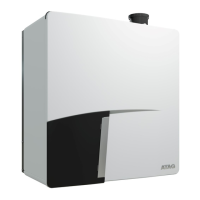Installation & Servicing Instructions ATAG Q-Series
26
9 Boiler controls
The boiler is provided with a fully automatic microprocessor control, called CMS Control
Management System. This control simplies operation by undertaking all major control
functions. Initially when power to the unit is switched on it will remain on standby. There
is no indication Led on, untill one of the programme keys is pressed. The control panel
display will show the relevant state. When the installation is empty the display will show
FILL.
The various parameters can be called up in two ways:
The Good-state or standard read out
The rst way shows a simple display read out.
The boiler in operation will always show 'Good'. When a message is necessary this will
be shown instead of Good.
Technical read out
The second way is a technical read out. In normal situations the following will be shown:
• on the left the status in which the boiler is active;
• on the right the ow temperature;
• the water pressure in the installation.
When a message (error or blocking code) is necessary this will be shown instead of the
technical read out..
To switch over from the Good-state to the Technical read out (and vice versa):
- Press 5 sec. on the STEP-key.
When the system has been lled the automatic venting program starts, when a programme
has been selected, by pressing the key for Central Heating, DHW or pump programme
(
, or ). The programme takes 17 minutes and stops automatically. After this
the unit will function normally. (See also 'Filling and venting the boiler and installation).
On a call for heating or hot water the control system will select the required water control
temperature. This water temperature is called the T-set value. On a call for central heating
the boiler ignites rst at low input. The input is then changed slowly to match the load
required. The boiler operates in this way to avoid excessive water noises and temperature
overshoot. On a call for hot water supply the T-set value of central heating return water
temperature is monitored. Depending on the amount of sanitary water which is withdrawn
from the DHW cylinder, the central heating return water temperature, from which the
input is adjusted, will vary.

